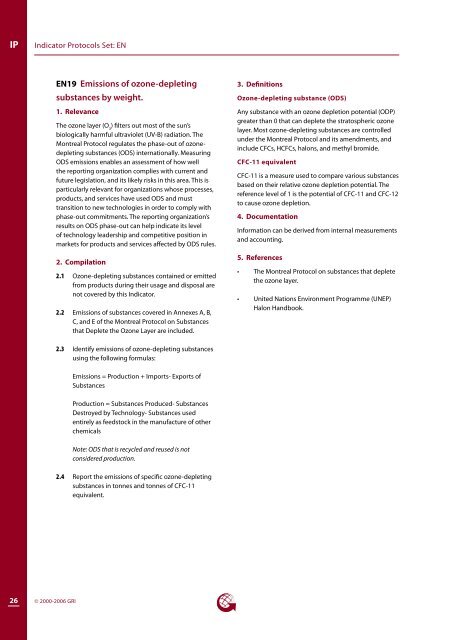Environment - Global Reporting Initiative
Environment - Global Reporting Initiative
Environment - Global Reporting Initiative
You also want an ePaper? Increase the reach of your titles
YUMPU automatically turns print PDFs into web optimized ePapers that Google loves.
IP<br />
Indicator Protocols Set: EN<br />
EN19 Emissions of ozone-depleting<br />
substances by weight.<br />
1. Relevance<br />
The ozone layer (O 3<br />
) filters out most of the sun’s<br />
biologically harmful ultraviolet (UV-B) radiation. The<br />
Montreal Protocol regulates the phase-out of ozonedepleting<br />
substances (ODS) internationally. Measuring<br />
ODS emissions enables an assessment of how well<br />
the reporting organization complies with current and<br />
future legislation, and its likely risks in this area. This is<br />
particularly relevant for organizations whose processes,<br />
products, and services have used ODS and must<br />
transition to new technologies in order to comply with<br />
phase-out commitments. The reporting organization’s<br />
results on ODS phase-out can help indicate its level<br />
of technology leadership and competitive position in<br />
markets for products and services affected by ODS rules.<br />
2. Compilation<br />
2.1 Ozone-depleting substances contained or emitted<br />
from products during their usage and disposal are<br />
not covered by this Indicator.<br />
2.2 Emissions of substances covered in Annexes A, B,<br />
C, and E of the Montreal Protocol on Substances<br />
that Deplete the Ozone Layer are included.<br />
3. Definitions<br />
Ozone-depleting substance (ODS)<br />
Any substance with an ozone depletion potential (ODP)<br />
greater than 0 that can deplete the stratospheric ozone<br />
layer. Most ozone-depleting substances are controlled<br />
under the Montreal Protocol and its amendments, and<br />
include CFCs, HCFCs, halons, and methyl bromide.<br />
CFC-11 equivalent<br />
CFC-11 is a measure used to compare various substances<br />
based on their relative ozone depletion potential. The<br />
reference level of 1 is the potential of CFC-11 and CFC-12<br />
to cause ozone depletion.<br />
4. Documentation<br />
Information can be derived from internal measurements<br />
and accounting.<br />
5. References<br />
• The Montreal Protocol on substances that deplete<br />
the ozone layer.<br />
• United Nations <strong>Environment</strong> Programme (UNEP)<br />
Halon Handbook.<br />
2.3 Identify emissions of ozone-depleting substances<br />
using the following formulas:<br />
Emissions = Production + Imports- Exports of<br />
Substances<br />
Production = Substances Produced- Substances<br />
Destroyed by Technology- Substances used<br />
entirely as feedstock in the manufacture of other<br />
chemicals<br />
Note: ODS that is recycled and reused is not<br />
considered production.<br />
2.4 Report the emissions of specific ozone-depleting<br />
substances in tonnes and tonnes of CFC-11<br />
equivalent.<br />
26<br />
© 2000-2006 GRI

















